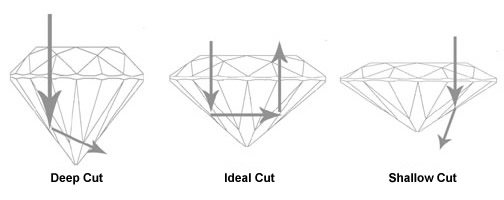Education
Our highly trained and experienced staff will educate you on your next jewellery purchase.
DIAMOND EDUCATION
Shopping for diamonds can be a daunting activity if you have never done it before, but with the right guidance and support you can be confident with any purchase. Diamonds have a comparative quality. While many diamonds look beautiful, it is hard to see the differences between them without comparing them side-by-side.
Hennick & Company Jewellery will assist you along the buying process to ensure that you get exactly what you are looking for by providing options for you to compare from our extensive diamond inventory.
In order to fully understand diamonds, you need to become familiar with diamond qualities as outlined by the Gemological Institute of America (GIA). These qualities are summarized as the 4 Cs: Cut, Colour, Clarity and Carat.
CUT
Cut is an essential component of the diamond beauty and value. The cut of a diamond ranges from Excellent / Ideal to Poor. Due to the advancement of diamond cutting technology, most newly mined diamonds have an excellent or very good cut.

The diamond cut is often confused with shape. While the cut of a diamond can be measured with different levels of quality, the shape of the diamond is totally based on personal preference.
COLOUR
Colour is generally considered the second most important of the 4 Cs when evaluating a diamond. The colour grade of a diamond refers to the lack of colour in a stone. The GIA colour grading starts with D, representing a “colourless” stone and goes down to Z. Diamonds in the D, E, F range are considered colourless and represent about 5% of all diamonds. G, H, I coloured diamonds are near colourless and are your more typical stone colours. Diamonds below I colour will begin to have noticeable colour and the colour will be more noticeable as the grading gets closer to Z.

CLARITY
A diamond Clarity is based on the number, size and location of imperfections within a diamond, called inclusions. Inclusions are a natural part of almost all diamonds, but most of them are not visible to the naked eye. The range of clarity starts with Internally Flawless and goes down to Included. Included diamonds can have blemishes that can be seen, but diamonds with a Slightly Included grade or above will not have any visible inclusions without using magnification lenses to inspect the diamond. The inclusion in the diamond may be hidden under a claw if it is positioned near the edge of the stone.

CARAT
The diamonds carat refers to the measurement of its weight. The weight and measurements of the diamond make up the overall size of the stone, which pricing relies heavily upon.
DIAMOND BUYING TIPS
Moving up one color grade won’t be as significant a price jump as moving up a clarity grade.
GOLD EDUCATION
When buying gold jewellery, you have several choices to make including the colour and karat of the gold. Hennick & Company Jewellery can assist you in navigating these choices as they relate to the gold and any diamonds or gemstones that you set in to the jewellery.
GOLD COLOUR
Gold jewellery is not pure gold. Gold jewellery is an alloy, which is a mixture of metals. Gold is often alloyed with silver, copper, zinc, palladium, and nickel to create different colours. The colour of your gold is based on personal preference, with the most common colours being yellow, white and rose gold.
Yellow gold is made by mixing pure gold with silver, copper and zinc. It is the purest in colour and the most hypoallergenic.
White gold is made by mixing gold and platinum (or palladium). White gold is excellent for setting a colourless or near colourless diamond as it does not project any colour through the stone.
White gold is more durable and scratch-resistant than yellow gold.
Rose gold (or pink gold) is alloyed with gold, copper, and silver. Due to the copper content in rose gold, it is more durable than white or yellow gold.
GOLD KARAT
The karat types of gold include 24, 22, 19.2, 18, 14 and 10, but the typical range in North America is 10-18k.
Error: Connected account for the user hennickandcojewellery does not have permission to use this feed type.
Try using the big blue button on the "Configure" tab to reconnect the account and update its permissions.
